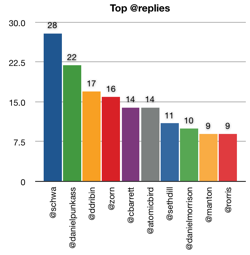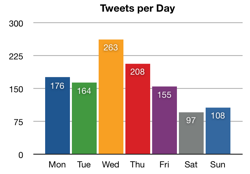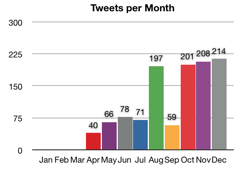One service that I've absolutely come to love in the past year is Twitter. I was a bit skeptical of it at first when I was introduced to it at South By Southwest in March. I met Alex, formerly of DC and now one of Twitter's engineers, and chatted about it a bit, plus lots of my friends were using it, but it just didn't seem like it was worth any time that I would put in. I mean, I get blogs and other expressions of day-to-day happenings that get put online, but I really didn't think anyone would care that I was "heading out to get a coffee" or "having trouble getting this thing to work" while working throughout the day.
However, later in the year, Twitter gradually became an indispensable part of my workday. I now use it as a sounding board with my colleagues, many of whom also work at home, and it's as near as I can come to having them as officemates. While things like chatrooms and IRC have existed, I found that I would have to go into a sort of conversation "mode" in order to use them, making them my primary task, so I didn't bother since this was very distracting. Whereas with Twitter (and the wonderful Twitterrific combined with Growl) on the desktop, I see snippets of conversation go by and I can either tune them out for a period while concentrating or take a moment to catch up and maybe reply. I've found innumerable answers to questions, met new people, discovered interesting places to go, and I've been able to help others in the same ways over the past months. I very much agree with the Iconfactory's Gedeon:
Twitter has allowed me to stay in touch with dear friends from college that have long since moved away. Twitter gives me a sounding board to bounce ideas off peers, is a reliable source for general knowledge, and lets me stay on top of the latest breaking news from around the world. But perhaps more than anything, it allows me to connect with like-minded individuals.
Naturally when I saw this Twitter stats script, I was intrigued to see what my numbers looked like. Call it internet naval-gazing, but I find it interesting to see who I had conversations with and how useful Twitter was to me over time.
See below for the stats and a couple comments on them.
 My top Twitter conversation partners
My top Twitter conversation partnersMostly other Mac developers (click for larger screenshot)
 My top Twitter reply recipients
My top Twitter reply recipientsAgain, mostly other Mac developers (click for larger screenshot)
 My Twitter usage by weekday
My Twitter usage by weekday Not much unexplained data here (click for larger screenshot)
 My hourly Twitter usage
My hourly Twitter usage Looks like I start on Twitter after catching up in the morning, plus occasionally have some late nights (click for larger screenshot)
 My Twitter monthly usage
My Twitter monthly usage You can see how my Twitter use really took off around this year's
C4 conference, slowed while I travelled three weeks of September for work & vacation, and then continued to grow through the end of the year (click for larger screenshot)
If you'd like to find out more about Twitter, you can start with their FAQ or follow their blog.
Thanks, Twitter! Here's to more great conversations in 2008.













